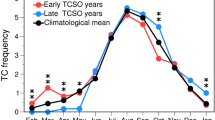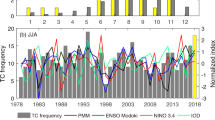Abstract
This chapter advances intelligent methodologies to study the modulation of cyclone genesis. Tropical cyclones (TCs) are hazardous weather elements with detrimental impacts on populations, wildlife, ecosystems, infrastructure, and the economy of developed as well as developing nations. Understanding the climatological behavior of TCs in relation to onsets, origin, and causal factors conductive to cyclogenesis can aid in the risk-management of cyclone vulnerability. This chapter studies the observed modulation of TC genesis in two study regions, namely the South Indian Ocean (SIO: 0–30° S, 30° E–130° E) and the South Pacific Ocean (SPO: 0–30° S, 130° E–130° W) was examined for the period 1980–2012. We define regional Madden–Julian Oscillation (MJO) indices based on the convective anomalies of large OLR variability centers, which exhibit a stronger modulation of the TC genesis than previously identified. Overall, an increase in the number of TC formations was recorded for the enhanced convective phase of the MJO compared to the dry phase. The modulation of TC genesis by MJO appeared to be pronounced with a ratio of 2:1 to the east of 70° E (for the SIO) and 7:1 to the west of 170° W (for the SPO). Stronger modulation in the latter region is attributable to (1) MJO-induced wind field impacts that were notably larger than the background mean flow, (2) TC genesis locations being consistent with MJO action centers, i.e., the TCs occur over the region of the MJO-induced low-level circulation with enhanced convection, and (3) TC genesis occurs in the South Pacific Convergence Zone (SPCZ), a region where MJO has a strong modulating effect. An analysis of large-scale dynamic and thermodynamic conditions demonstrated that low-level relative vorticity was strongly related to TC genesis modulation in both the SIO and SPO regions. However, the MJO appears to show little effect on TC genesis in the western SIO due to the existence of climatological conditions less conducive to TC formation throughout the cyclonic season. Finally, the chapter ascertains that TCs are generally produced further from the equatorial region in the southwest Indian zone where the MJO signal appears to be very weak.
Access this chapter
Tax calculation will be finalised at checkout
Purchases are for personal use only
Similar content being viewed by others
Abbreviations
- ECMWF:
-
European Centre for Medium-Range Weather Forecasts
- ENSO:
-
El-Niño Southern Oscillation
- ITCZ:
-
Intertropical Convergence Zone
- JTWC:
-
Joint Typhoon Warning Center
- HYCOM:
-
Hybrid Coordinate Ocean Model
- MJO:
-
Madden–Julian Oscillation
- NCEP:
-
National Center for Environmental Prediction
- NH:
-
Northern Hemisphere
- OLR:
-
Outgoing Longwave Radiation
- RH:
-
Relative Humidity
- SH:
-
Southern Hemisphere
- SIO:
-
South Indian Ocean
- SPCZ:
-
South Pacific Convergence Zone
- SPO:
-
South Pacific Ocean
- SST:
-
Sea Surface Temperature
- TC:
-
Tropical Cyclone
- TRMM:
-
Tropical Rainfall Measuring Mission
- U:
-
Zonal wind component
- V:
-
Meridional wind component
- WH04:
-
Wheeler and Hendon 2004
References
Arnault J, Roux F (2011) Characteristics of African easterly waves associated with tropical cyclogenesis in the Cape Verde Islands region in July–August–September of 2004–2008. Atmos Res 100(1):61–82
Basher R, Zheng X (1995) Tropical cyclones in the southwest Pacific: spatial patterns and relationships to southern oscillation and sea surface temperature. J Clim 8(5):1249–1260
Bessafi M, Wheeler MC (2006) Modulation of South Indian Ocean tropical cyclones by the Madden-Julian Oscillation and convectively coupled equatorial waves. Mon Weather Rev 134(2):638–656
Callaghan J, Power SB (2011) Variability and decline in the number of severe tropical cyclones making land-fall over eastern Australia since the late nineteenth century. Clim Dyn 37(3–4):647–662
Camargo SJ, Wheeler MC, Sobel AH (2009) Diagnosis of the MJO modulation of tropical cyclogenesis using an empirical index. J Atmos Sci 66(10):3061–3074
Chand SS, Walsh KJ (2010) The influence of the Madden-Julian oscillation on tropical cyclone activity in the Fiji region. J Clim 23(4):868–886
Duvel JP, Roca R, Vialard J (2004) Ocean mixed layer temperature variations induced by intraseasonal convective perturbations over the Indian Ocean. J Atmos Sci 61(9):1004–1023
Frank WM (1987) Tropical cyclone formation. A global view of tropical cyclones, pp 53–90
Gray WM (1968) Global view of the origin of tropical disturbances and storms. Mon Weather Rev 96(10):669–700
Gray WM (1979) Hurricanes: their formation, structure and likely role in the tropical circulation. Meteorol Over Tropical Oceans 77:155–218
Gray WM (1998) The formation of tropical cyclones. Meteorol Atmos Phys 67(1–4):37–69
Hall JD, Matthews AJ, Karoly DJ (2001) The modulation of tropical cyclone activity in the Australian region by the Madden-Julian Oscillation. Mon Weather Rev 129(12):2970–2982
Han W, Yuan D, Liu WT, Halkides D (2007). Intraseasonal variability of Indian Ocean sea surface temperature during boreal winter: Madden–Julian Oscillation versus submonthly forcing and processes. J Geophys Res Oceans 112(C4)
Hendon HH, Salby ML (1994) The life cycle of the Madden-Julian oscillation. J Atmos Sci 51(15):2225–2237
IPCC (2007) Summary for Policymakers. In: Climate change 2007: the physical science basis. contribution of working group i to the fourth assessment report of the intergovernmental panel on climate change. Cambridge University Press, United Kingdom and New York, NY, USA
Jones C, Carvalho LM (2014) Sensitivity to Madden–Julian Oscillation variations on heavy precipitation over the contiguous United States. Atmos Res 147:10–26
Kalnay E et al (1996) The NCEP/NCAR 40-year reanalysis project. Bull Am Meteor Soc 77(3):437–471
Kiladis GN et al (2014) A comparison of OLR and circulation-based indices for tracking the MJO. Mon Weather Rev 142(5):1697–1715
Kiladis GN, Weickmann KM (1992) Circulation anomalies associated with tropical convection during northern winter. Mon Weather Rev 120(9):1900–1923
Klotzbach PJ (2014) The Madden–Julian oscillation’s impacts on worldwide tropical cyclone activity. J Clim 27(6):2317–2330
Knutson TR, Weickmann KM (1987) 30–60 day atmospheric oscillations: Composite life cycles of convection and circulation anomalies. Mon Weather Rev 115(7):1407–1436
Kuleshov Y et al (2010) Trends in tropical cyclones in the South Indian Ocean and the South Pacific Ocean. J Geophys Res Atmos 115(D1)
Kuleshov Y, Qi L, Fawcett R, Jones D (2008) On tropical cyclone activity in the Southern Hemisphere: trends and the ENSO connection. Geophys Res Lett 35(14)
Kuleshov Y, Ming FC, Qi L, Choaibou I, Hoareau C, Roux F (2009) Tropical cyclone genesis in the southern hemisphere and its relationship with ENSO. Ann Geophys 27:2423–2538
Liebmann B (1996) Description of a complete (interpolated) outgoing longwave radiation dataset. Bull Amer Meteor Soc 77:1275–1277
Liebmann B, Hendon HH, Glick JD (1994) The relationship between tropical cyclones of the western Pacific and Indian Oceans and the Madden-Julian oscillation. J Meteorol Soc Jpn 72(3):401–412
Madden RA, Julian PR (1971) Detection of a 40-50 day oscillation in the zonal wind in the tropical Pacific. J Atmos Sci 28(5):702–708
Madden RA, Julian PR (1972) Description of global-scale circulation cells in the tropics with a 40–50 Day Period. J Atmos Sci 29:1109–1123. https://doi.org/10.1175/1520-0469(1972)029<1109:DOGSCC>2.0.CO;2
Maloney ED, Hartmann DL (2000a) Modulation of eastern North Pacific hurricanes by the Madden-Julian oscillation. J Clim 13(9):1451–1460
Maloney ED, Hartmann DL (2000b) Modulation of hurricane activity in the Gulf of Mexico by the Madden-Julian oscillation. Science 287(5460):2002–2004
McBride JL, Zehr R (1981) Observational analysis of tropical cyclone formation. Part II: Comparison of non-developing versus developing systems. J Atmos Sci 38(6): 1132–1151
Nakazawa T (1988) Tropical super clusters within intraseasonal variations over the western Pacific. J Meteor Soc Japan 66:823–839
Nott J (2011) Tropical cyclones, global climate change and the role of Quaternary studies. J Quat Sci 26(5):468–473
Peduzzi P et al (2012) Global trends in tropical cyclone risk. Nat Clim Change 2(4):289–294
Rui H, Wang B (1990) Development characteristics and dynamic structure of tropical intraseasonal convection anomalies. J Atmos Sci 47(3):357–379
Roy C, Kovordányi R (2012) Tropical cyclone track forecasting techniques-a review. Atmos Res 104:40–69
Saji N, Xie SP, Tam CY (2006) Satellite observations of intense intraseasonal cooling events in the tropical south Indian Ocean. Geophys Res Lett 33(14)
Shinoda T, Hendon HH (1998) Mixed layer modeling of intraseasonal variability in the tropical western Pacific and Indian Oceans. J Clim 11(10):2668–2685
Sinclair MR (2002) Extratropical transition of southwest Pacific tropical cyclones. Part I: climatology and mean structure changes. Monthly Weather Rev 130(3): 590–609
Terry JP, Gienko G (2010). Climatological aspects of South Pacific tropical cyclones, based on analysis of the RSMC-Nadi (Fiji) regional archive
von Storch H, Xu J (1990) Principal Oscillation Pattern analysis of the tropical 30–60 day oscillation. Part I: definition of an index and its prediction. Clim Dyn 4:179–190
Walker GT, Bliss EW (1930) World weather IV. Memoirs Roy Meteorol Soc 3(24):81–95
Walker GT, Bliss EW (1937) World weather VI. Memoirs Roy Meteorol Soc 4(39):119–139
Wang B, Yang H (2008) Hydrological issues in lateral boundary conditions for regional climate modeling: Simulation of East Asian summer monsoon in 1998. Clim Dyn 31(4):477–490
Webster P, Holland G, Curry J, Chang H (2005) Changes in tropical cyclone number, duration, and intensity in a warming environment. Science 309(5742):1844–1846
Wheeler MC, Hendon HH (2004) An all-season real-time multivariate MJO index: development of an index for monitoring and prediction. Mon Weather Rev 132(8):1917–1932
Woolnough SJ, Slingo JM, Hoskins BJ (2000) The relationship between convection and sea surface temperature on intraseasonal timescales. J Clim 13(12):2086–2104
Yun KS, Chan JC, Ha KJ (2012) Effects of SST magnitude and gradient on typhoon tracks around East Asia: Acase study for Typhoon Maemi (2003). Atmos Res 109:36–51
Zhang C (2005) Madden–Julian oscillation. Rev Geophys 43(2)
Zhang F, Tao D (2013) Effects of vertical wind shear on the predictability of tropical cyclones. J Atmos Sci 70:975–983. https://doi.org/10.1175/JAS-D-12-0133.1
Author information
Authors and Affiliations
Corresponding author
Editor information
Editors and Affiliations
Rights and permissions
Copyright information
© 2021 Springer Nature Singapore Pte Ltd.
About this chapter
Cite this chapter
Dayal, K.S., Wang, B., Deo, R.C. (2021). Modulation of Tropical Cyclone Genesis by Madden–Julian Oscillation in the Southern Hemisphere. In: Deo, R., Samui, P., Kisi, O., Yaseen, Z. (eds) Intelligent Data Analytics for Decision-Support Systems in Hazard Mitigation. Springer Transactions in Civil and Environmental Engineering. Springer, Singapore. https://doi.org/10.1007/978-981-15-5772-9_7
Download citation
DOI: https://doi.org/10.1007/978-981-15-5772-9_7
Published:
Publisher Name: Springer, Singapore
Print ISBN: 978-981-15-5771-2
Online ISBN: 978-981-15-5772-9
eBook Packages: Intelligent Technologies and RoboticsIntelligent Technologies and Robotics (R0)




